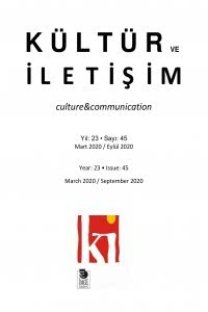Güneşe Yolculuk Filmi Üzerine Göstergebilimsel inceleme
Osmanlı devletinin çok kimlikli ve çok dinli yapısından, 20. yüzyılın başında Türkiye Cumhuriyeti'nin ulus-devlet yapısına geçişle birlikte, modern ulus devletin vatandaşlık tanımı egemen olmuştur. Bu tanımlama politik ve kültürel açıdan eleştirilen bir kavram olagelmiştir. Bu çalışmada Ötekilik kavramı altında Türkiye'deki etnik grupları konu alan Güneşe Yolculuk (Yeşim Ustaoğlu) inceleme nesnesi olarak seçilmiştir. Filmin düz anlamını oluşturan gösterenlerin/teknik kodlarınaçımlanmasının ardından, imgelendirilmiş söylev, Greimas'ın göstergebilimsel yöntemiyle çözümlenmiştir. Bu çözümlemede film önce söylemsel düzeyde, kişilerin uzam ve zaman içinde ortaya çıkış sırasına göre kesitlenmiştir. Anlatısal düzeyde ise, kişilerin anlatı izlenceleri içindeki işlevleri değerlendirilmiştir. Derin düzeyde ise içeriğin temel yapısı araştırılmıştır. Buna göre filmsel öykü sürecinde önyargıların şekillendirdiği, bizden olmayana karşı gösterilen indirgeyici bakış, farklılığa işaret etmekten çok, biz ve onlar arasındaki ayrımı giderek derinleştirmiştir. Filmin derin düzeyinin bütünleyicilik bağıntısında görüldüğü şekilde, dışlanan grubun bireyi olarak Berzan bulunduğu kenti değiştirse bile toplumsal önyargılardan kurtulamamış ve hayal ettiği özgür ve gönençli yaşama kavuşamamıştır.
Anahtar Kelimeler:
güneşe yolculuk, göstergebilim, film çözümlemesi
A Semiotic Analysis on the Film "'Journey Towards Sun"
During the shift from multi-ethnic and multi-cultural structure of the Ottoman Empire to the Turkish Republic at the beginning of the 21. century, a new citizenship definition has been introduced as a consequence of the nation-state ideology. This definition of citizenship has become the target for political and cultural criticisms. Within the limits of this article, the film by Yeşim Uslaoğlu entitled Güneşe Yolculuk (Journey Towards Sun) is selected to conduct a case study over the films on the theme of "otherness. Succeeding the elucidation of the denotations or the technical codes in the film, the cinematographic discourse has been analysed with the semiotic method of Greimas. During the analysis of the discourse, the segmentation has been made in accordance with the rank of appearance of the characters in spatio-temporal flow. The functions of the characters in the narrative programme have been also primary due to the analysis of the narrative level. On the third phase, the deep structure analysis has been attributed to the basic structure of the content in general. As one of the conclusions of the deep structure analysis, it can be said that any discrimination based on ethnicity brings to reductionist approach. This reductionist approach against the others is an outcome of the prejudices and it enlargens the gap between "us" and "them," instead of indicating the difference. As it can be seen at the exclusive relation of the deep structure analysis that Berzan as a member of the minority group, could neither change his life nor find peace and wealth he was dreaming for, although he tried to move from the city where he lives.
___
- Adanır, Oguz (1987). Sinemada Anlam ve Anlatımı, İzmir: Tumer Mtb.
- Barthes, Roland (1989). Anlatıların Yapısal Çözümlemesine Giriş, İstanbul: Gerçek Yayınları.
- Burçoğlu, N. K. (1997). Multiculturalism: Identity and Otherness, İstanbul: Boğaziçi University Publications.
- Bostancı, M. N. (1999). Bir Kolektif Bilinç Olarak Milliyetçilik, istanbul: Doğan Kitapçılık AŞ.
- Büker, Seçil (1985). Sinemada Anlam Yaratma, Eskişehir: Milliyet Yayınları.
- ISSN: 1301-7241
- Yayın Aralığı: Yılda 2 Sayı
- Başlangıç: 1998
- Yayıncı: İmge Kitabevi Yayınları
Sayıdaki Diğer Makaleler
Zındık ve Sapkın: Türk ve İslam Topluluklarında Demonik Düşünce
Yoksulluk Halleri: Türkiye'de Kent Yoksulluğunun Toplumsal Görünümleri
Türkiye 'de İletişim Eğitimi: Elli Yıllık Bir Geçmişin Değerlendirilmesi
From Confucianism to Consumerism: Women, Food and the Media in Contemporary Korea
Güneşe Yolculuk Filmi Üzerine Göstergebilimsel inceleme
Küresel Bağlamda Ulusal Siyasalar: Britanya Örneği
